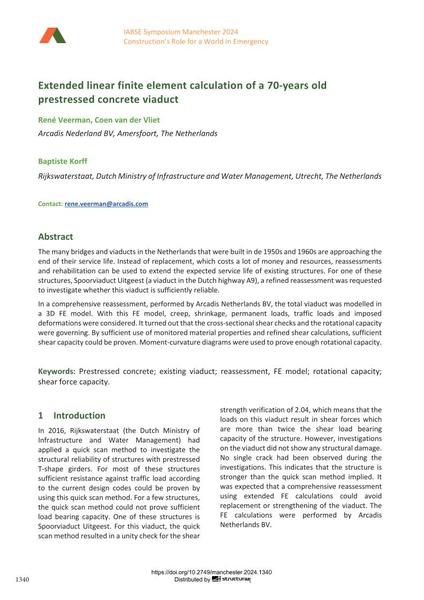Extended linear finite element calculation of a 70-years old prestressed concrete viaduct

|
|
|||||||||||
Bibliografische Angaben
| Autor(en): |
Rene Veerman
(Arcadis Nederland BV, Amersfoort, The Netherlands)
Coen van der Vliet (Arcadis Nederland BV, Amersfoort, The Netherlands) Baptiste Korff (Rijkswaterstaat, Dutch Ministry of Infrastructure and Water Management, Utrecht, The Netherlands) |
||||
|---|---|---|---|---|---|
| Medium: | Tagungsbeitrag | ||||
| Sprache(n): | Englisch | ||||
| Tagung: | IABSE Symposium: Construction’s Role for a World in Emergency, Manchester, United Kingdom, 10-14 April 2024 | ||||
| Veröffentlicht in: | IABSE Symposium Manchester 2024 | ||||
|
|||||
| Seite(n): | 1340-1347 | ||||
| Anzahl der Seiten (im PDF): | 8 | ||||
| DOI: | 10.2749/manchester.2024.1340 | ||||
| Abstrakt: |
The many bridges and viaducts in the Netherlands that were built in de 1950s and 1960s are approaching the end of their service life. Instead of replacement, which costs a lot of money and resources, reassessments and rehabilitation can be used to extend the expected service life of existing structures. For one of these structures, Spoorviaduct Uitgeest (a viaduct in the Dutch highway A9), a refined reassessment was requested to investigate whether this viaduct is sufficiently reliable. In a comprehensive reassessment, performed by Arcadis Netherlands BV, the total viaduct was modelled in a 3D FE model. With this FE model, creep, shrinkage, permanent loads, traffic loads and imposed deformations were considered. It turned out that the cross-sectional shear checks and the rotational capacity were governing. By sufficient use of monitored material properties and refined shear calculations, sufficient shear capacity could be proven. Moment-curvature diagrams were used to prove enough rotational capacity. |
||||
| Stichwörter: |
FE-Modell
|
||||
